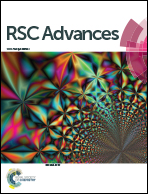Small bandgap naphthalene diimide copolymers for efficient inorganic–organic hybrid solar cells
Abstract
Two low band-gap naphthalene diimide (NDI)-based conjugated polymers have been designed and grafted with benzo[1,2-b:4,5-b′]dithiophene (BDT) or dithieno [3,2-b:2′,3′-d]pyrrole (DTP) by a Stille cross-coupling reaction. Inorganic–organic hybrid solar cells (HSCs) based on the copolymers deliver high performances by suitable molecular design and careful selection of chemical structures with different electronic nature. The well designed copolymers exhibit broader solar light absorption, which is attributed to their smaller band gaps. Density functional theory calculations and cyclic voltammetry characteristics reveal that the copolymers have small band gaps and deep HOMO and LUMO energy levels. Moreover, after introducing the copolymers, the energy level formation of the bulk-heterojunction become more matched, thus giving rise to excellent photovoltaic performances as HSCs. The results showed that an NDI-based copolymer with DTP donor segments exhibits a higher power conversion efficiency of 2.36%. This work highlights the development of bipolar host materials with a focus on molecular design strategies, which benefits the light harvest and enhances the efficiency by well aligned energy level formation.


 Please wait while we load your content...
Please wait while we load your content...